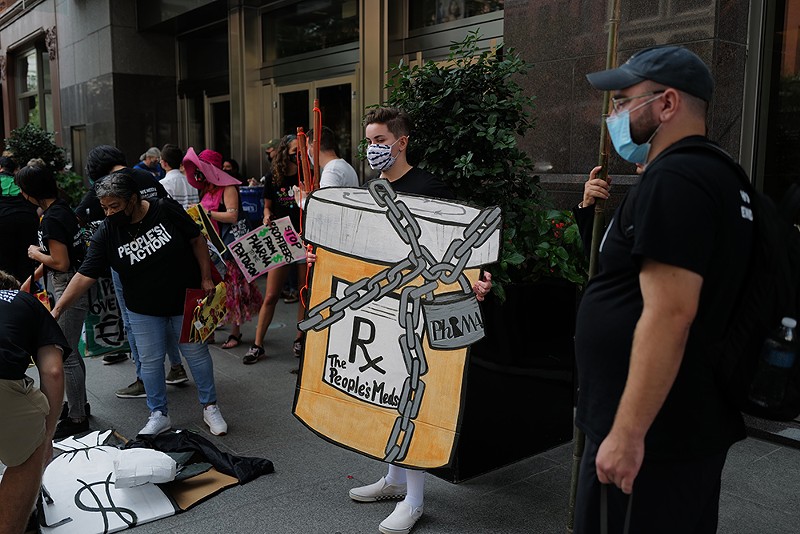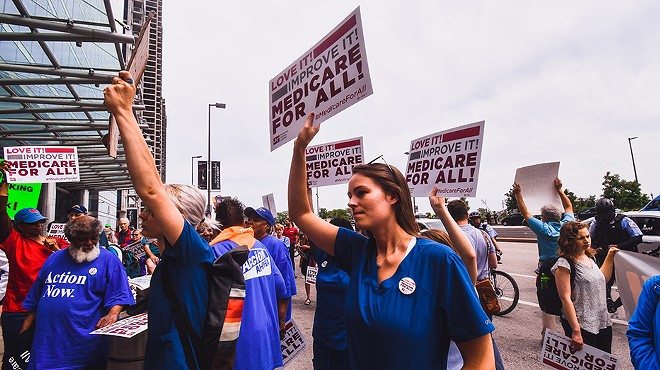Friends, last week I found myself on Capitol Hill in Washington, D.C. to testify before the Senate Budget Committee on Medicare for All. I wanted to share my written testimony with you, laying out the case for Medicare for All — and how it would solve not just a limited set of our challenges, but all of them. You can watch the testimony at budget.senate.gov.
My name is Dr. Abdul El-Sayed, I trained as a physician and epidemiologist. I served the City of Detroit as Health Director between 2015 and 2017, where I was responsible for the basic health and welfare of nearly 700,000 Detroiters. I also led the rebuilding of the Detroit Health Department after it had been privatized during municipal bankruptcy and financial takeover by the State of Michigan under the same system of emergency management that led to the Flint Water Crisis.
Today, I teach at the University of Michigan’s Ford School of Public Policy, as well as American University’s School of Public Affairs. I find myself shouldering the awkward responsibility of explaining the haphazard dysfunction of American healthcare to some of the brightest young policy minds in the country. I watch my students’ faces crinkle when I explain how deductibles work — comparing them to having to pay $19.99 for each movie you watch on Netflix even though you already pay for your monthly subscription. Last year, my book on the very subject of this hearing, along with Dr. Micah Johnson, Medicare for All: A Citizen’s Guide was published by Oxford University Press. I have given a copy to each of your offices.
I want to start with the two most obvious problems in American healthcare: 1) We fail to provide everyone health insurance coverage. 2) The cost of healthcare in America is spiraling upward.
Coverage
We like to think of ourselves as “customers” of healthcare. But we are not. To understand why, let’s review how being a “customer” actually works. Imagine you were to go to a farmer’s market in search of some heirloom tomatoes. There are multiple varieties all at different prices.
Let’s say you find a stall with some tomatoes you like. You ask the seller for the price. If that price is too high, you move on. But if it’s fair, you purchase them. You tender payment — and you are now the proud owner of heirloom tomatoes.
That is a normal customer experience.
But that’s not how we experience healthcare. Imagine I was to complain of chest pain during this hearing. I’d be exhibiting signs of a potentially deadly heart attack. I should hope that you would call 911. When the ambulance comes, I would have no choice as to where I was going — no choice of who would “sell” me healthcare. Indeed, I would need to be taken to the nearest hospital. Time is wasting.
When I arrive, I have no choice in the care I get or from whom I get it — I’m left at the mercy of the physicians assigned to provide me care. But there are several directions my care could go depending on the physician, the services provided at the hospital, and what they deem my pathology to be. No one ever shares a price list for the care I will receive.
Afterwards, a bill is sent to my health insurer. My insurer is based in Michigan, while I would have had my heart attack in Washington, D.C., so I would have received out-of-network care. It is unclear exactly how much of the cost of my care they will pay. But it is May, and my family and I have been healthy this year. We have yet to pay down our deductible — the paywall in front of the health insurance my family pays a premium for every month. So, some of the cost would get pushed back to me. Either way, my insurance pays for my healthcare, and sends me a bill for whatever it will not cover.
Now compare this experience to the traditional “customer” experience I laid out at the farmer’s market. I do not get to shop around between providers. I do not get to choose what product I want owing to the “information asymmetry” — the difference in knowledge between my provider and me. I am left to the provider to both tell me what I need and sell it to me. I am never asked what price I am willing to pay. It’s assumed I’ll pay whatever it costs considering I only have one heart that is priceless to me, a perfect example of what economists call “inelastic demand”; my demand for care does not change based on price. And finally, once I receive my care, I do not pay. Instead, a third-party insurer pays on my behalf and passes whatever it will not back on to me.
Rather than being the initiator and completer of a financial transaction, I am the reason a financial transaction between my insurer and provider has taken place. Ask yourself, in the traditional “customer” analogy: are we the customers ... or the tomatoes?
Our profit-driven healthcare system renders our bodies into products, over which providing healthcare justifies financial transactions between major corporations. Healthcare is not a traditional market product because it violates so many of the requirements of the market. We are not the ones who pay for our healthcare. We often receive healthcare in circumstances that preclude us from negotiating. We rely on our providers to both tell us what we need and to sell it to us.
Ask yourself, in the traditional “customer” analogy: are we the customers ... or the tomatoes?
tweet this
It's no wonder why “market-based healthcare” so obviously fails. If I were a customer, I would be free to walk away if the price is too expensive. That fact would force any seller to lower their prices if they wanted the sale. That’s the power of negotiation in a true market — the fact that you do not have to buy. But in our system, no one can walk away. As a patient, I don’t have time. As an insurer, the care has already been provided. So instead of keeping prices down, health insurance companies have realized that they can just pass more of their costs back onto us.
Premiums — what we pay every month for the privilege of “being insured” — have risen faster than wages and inflation over the past decade. The median family premium is now $22,221 — nearly $6,000 of that is coming out of family, not employer, pockets.
Considering that the median family earned about $80,000 in 2021, they spent 7.5 percent of their earnings on premiums. But that’s not where the healthcare cost burden ends. Deductibles usually sit around $4,000 for private family plans. That makes the annual cost of private health insurance nearly $10,000 per year, or 12.5 percent of the median family budget before taxes.
Out of pocket costs in the forms of deductibles and co-pays are not just financially costly, but they’re also physically costly. Having to pay a deductible delays necessary healthcare. One study found that high deductibles delayed treatment for breast cancer by nearly nine months. Worse still, deductibles have more than doubled over the past decade.
All of this contributes to the irony that the operative part of the word “insurance” is “sure.” And the structure of our for-profit system leaves Americans increasingly unsure about their health insurance access. The nature of insurance coverage, itself, has changed. It’s no wonder that nearly 44 percent of adults struggle to afford their care, and 30 percent report rationing care because they cannot afford it.
And that’s for people who are winning in our for-profit healthcare system. These are the privately insured Americans who are routinely told that they have the “greatest healthcare in the world.” What about those who are losing in our profit-driven system? That includes, of course, the uninsured of whom there remain 28 million according to the 2020 census. That includes 9 percent of America’s children.
It also includes about 87 million Americans enrolled in Medicaid, our federally funded, state- operated health insurance program for low-income Americans. While Medicaid is a critical program, a lifeline for millions of Americans who cannot afford private health insurance, the program is only just that: a lifeline. Medicaid reimbursements, on average, are substantially lower than private insurance reimbursements. And because healthcare providers are not required to accept Medicaid, beneficiaries are, in effect, second-class healthcare citizens. It is impossible to escape the fact that reimbursing the same healthcare services at a lower rate reflects an implicit lack of value of the body for which the healthcare is being provided. One study found that just a $10 increase in Medicaid reimbursements led to a 0.3 percent increase in the probability that a Medicaid beneficiary had seen a physician in the past two weeks.
Because Americans of color are substantially more likely to be insured on Medicaid than their white counterparts, our tiered healthcare system is just another means by which our healthcare system assents to fundamental health inequities. Empirically, our system literally values Black bodies less than it does white ones.
Costs
We spend a whopping $12,530 per capita on healthcare — more, by far, than any other country on Earth. Our neighbors just north spend less than half as much ($5,370). And the costs are rising faster than comparable countries, too.
Why do healthcare costs keep rising? Because corporations make money when they do. Healthcare providers make more when they bill more. Hospitals mergers and acquisitions continue to surge. And as hospitals buy one another up in mergers and acquisitions, they eliminate their competition. One study found that hospital consolidation was associated with increased healthcare prices, often as high as 20 percent.
You might expect health insurance companies have an incentive to negotiate healthcare costs downward on behalf of consumers, acting as a check on rising healthcare costs. But instead of negotiating these prices downward, insurers have leveraged cost-sharing mechanisms to pass rising costs back onto American families.
There are also the unintended consequences of the “80/20 rule” which required health insurance companies to spend at least 80 percent of their annual collected premiums on healthcare or return anything in excess back to beneficiaries in the form of a premium rebate. While it was intended to keep premiums low, it also removed the incentive health insurers had to negotiate down provider billing. All of this illustrates the fundamental failure of assuming that negotiations over healthcare costs between profit-driven insurers and healthcare providers on behalf of the American public would do anything but maximize the profits of both sets of corporations at the expense of the public.
The pandemic shows us how America’s healthcare failures extend well beyond this
Now that I have discussed the most obvious problems with American healthcare, I want to expand the aperture. Though we often frame our healthcare discussion simply around coverage and cost, this framing specifically excludes some of the most important issues facing health and healthcare in America.
To help us understand these, I want to take us back just two (albethey extraordinarily long) years, to early 2020. None of us will forget the horror of the first days of the pandemic that spring. We were facing a new virus with very little information about how it spread, how deadly it might be, and who was at highest risk. We had no vaccine nor any effective treatments. We were watching hospital wards fill up — their staff struggling without the ventilators or beds they needed to treat patients.
Frontline nurses, doctors, and hospital workers were doing all this without the basic personal protective equipment they needed to protect themselves and their patients from what was then called the “novel coronavirus.” Indeed, this added to the already chronically poor working conditions for many healthcare workers—including unsustainable and unsafe staffing ratios, mandatory overtime, and vicious union-busting. Today, nurses are being forced to travel for more lucrative locum opportunities where they work alongside permanent colleagues who make far less for the same work — all this cementing a permanent staffing crisis in America’s hospitals.
Desperate to “flatten the curve,” mayors and governors around the country were forced to close schools and issue stay at home orders. We watched millions of Americans already teetering on the edge of financial insolvency lose their livelihoods. With their jobs, up to 27 million Americans also lost employer-sponsored health insurance during the pandemic.
Meanwhile, local and state health departments, as well as the CDC, anemic after decades of disinvestment through the austerity of the Great Recession, struggled under the load of the pandemic. Burnt out from the experience, a third of public health workers in a national survey say they are considering leaving the public health workforce in the next year.
Despite the stress the pandemic put on hospitals around the country — and the desperate need that communities had for hospital beds — 21 hospitals shut down or ended service in the course of 2020 alone. These hospitals are shutting down in disproportionally rural communities and in states that did not expand Medicaid. Millions of Americans are being forced to drive further and further for medical care, those distances posing serious obstacles in emergencies.
Hospitals, despite being gorged with patients, were being starved for cash flow. The pandemic forced them to cancel their most lucrative elective procedures to make way for COVID-19 patients. But it wasn’t only shutdowns that robbed people of healthcare options; 2020 also featured 73 hospital mergers or acquisitions that leave patients around the country with fewer choices for care. More than one in three (37 percent) of these deals involved a for-profit healthcare system, up from less than one in four (23 percent) in 2019.
Along with for-profit hospitals, guess what other industry had a banner year in 2020? The health insurance industry. Suddenly, they were flush with all the money they should have had to spend on elective procedures. UnitedHealth Group made $6.7 Billion in profits in the second quarter of 2020 — nearly double the $3.4 billion it made in the same quarter in 2019.
Where did they put that money? Well, 2020 was an election year — so they invested in making sure that nothing fundamentally changed about the nature of our healthcare system. They plowed that money back into our political process through everything from lobbying to electioneering. In the 2020 cycle, Blue Cross/Blue Shield—the biggest political spender among health insurers — spent $6,406,253 in political contributions. It also spent a whopping $49,879,310 lobbying. It was a key sponsor of the “Partnership for America’s Healthcare Future,” a lobbying group that ran millions of dollars in ads throughout the 2020 cycle to specifically target Medicare for All.
The pandemic has claimed nearly a million American lives. It’s claimed millions more livelihoods. U.S. life expectancy fell by several years — even more so among people of color — erasing a quarter century of growth.
This singular health catastrophe demonstrates so many of the other healthcare challenges in America in addition to coverage and cost.
American healthcare is precarious. Employer sponsored insurance means that while you may have health insurance today, you could lose it for several reasons: losing a job, getting a new job, turning 26, getting married, getting divorced, or striking at work. Beyond that, in an America where we believe in the can-do entrepreneurial spirit, consider how many businesses are left unbuilt, career opportunities left unpursued for fear of losing health insurance.
2. American consumers are losing healthcare choices. The choice that Americans want in healthcare isn’t which health insurer, but which doctor to see or what hospital to go to. But mergers and acquisitions, let alone hospital closures, are robbing Americans of the healthcare choices that matter most to them.
3. Healthcare workers are being exploited. The power of consolidating healthcare companies leaves healthcare workers — nurses, doctors, and other healthcare workers — at a disadvantage. When large hospital chains consolidate, workers are left with limited alternatives, reducing their ability to hold their employers accountable for unsafe staffing, forced overtime, and unsafe working conditions. They also fall prey to the well- documented reduction of pay due to what economists call “monopsony” — the ability of oligopolies to collude to suppress wages.
4. We are failing to invest in prevention and public health. Our public health institutions were responding to the worst pandemic in modern history on shoestring budgets. But the continued defunding of public health does not align with Americans’ preferences. If given the choice, most Americans would choose to stay healthy rather than pay for healthcare after they’ve already gotten sick. But our healthcare system rakes in trillions of dollars, nearly a fifth of our entire gross domestic product, to pay for healthcare while our national investment in public health — the means of keeping Americans healthy — remains minimal. We live far shorter lives than our counterparts in other high-income countries. Germany’s life expectancy, for example, is more than four years longer than ours.
Medicare for All: a single solution for all our healthcare problems
Well-meaning people often attempt to explain why alternative proposals to Medicare for All could also provide universal coverage and reduce our healthcare costs. But as discussed, assuming that those are the only two problems we must solve hinges on a limited understanding of the full scope of America’s healthcare challenges. When I introduce those challenges — the closing of rural hospitals, the expansion of for-profit healthcare through mergers and acquisitions that eliminate choice, the defunding of American public health, the exploitation of America’s healthcare workforce, the tiered nature of our health insurance system that turns low-income Americans into second-class healthcare citizens — they propose Rube Goldberg add-on policies that render their proposals so complex as to be unworkable.
Medicare for All — a universal national health insurance program for everyone — is the most elegant, affordable, understandable, equitable solution to our myriad healthcare challenges. Having enumerated a fuller scope of America’s healthcare challenges, I want to map how Medicare for All would solve each of these.
Medicare for All would reduce the costs of healthcare for individuals, families, and the country — and expand the economy.
tweet this
Medicare for All would provide universal health insurance coverage. Medicare for All would offer the clearest pathway universal healthcare insurance coverage. Every single resident would have cradle-to-grave coverage. That coverage would insulate Americans from the escalating premiums, co-pays, and deductibles that leave even privately-insured Americans rationing, delaying, or forgoing healthcare right now.
Medicare for All would do away with second class healthcare citizenship. It would finally offer the equitable health insurance every single American deserves. Regardless of what you earn, the color of your skin, or wear you work, you would be entitled to the same coverage — that reimburses at the same rate — as everyone else. This would save lives. A Yale study found that Medicare for All would save up to 68,000 lives every year.
Medicare for All is durable. Turn 26, get a job, lose a job, get married, get divorced: none of these would cost you your health insurance under Medicare for All. Regardless of the nature of their employment, Americans would be secure in the knowledge that they would not lose their health insurance. Beyond the peace of mind, this would support America’s economy as well: it could unleash the entrepreneurial spirit of Americans to start new businesses or explore new career opportunities without worrying about what it might mean should they or their families fall ill.
Medicare for All would slow the hospital mergers, acquisitions, and shutdowns that rob American consumers of their healthcare choices. Mergers and acquisitions, let alone hospital closures, are robbing millions of Americans of the choice of what doctor to see or what hospital to go to. These deals are driven by non-transparent negotiations over reimbursement rates between hospitals and health insurers. Larger hospitals can leverage their size to negotiate better reimbursement rates than their competitors—allowing them to press their advantage and ultimately purchase their competitors. Meanwhile, hospitals in low-income or rural communities shut down because their communities lack density or people with private insurance, leaving residents with no healthcare options at all.
Under Medicare for All, there would be just a single insurer. Hospitals in similar catchment areas would be reimbursed at the same rate for the care they provide, barring larger hospitals from commanding better reimbursement rates simply for being larger. This allows smaller hospitals, as well as independent practices, to remain competitive, and offers consumers more choice.
Similarly, Medicare for All would keep rural hospitals open through “global payments” — rather than reimbursing for each unit of healthcare they provide, these hospitals would be paid in lump sum for the critical services they provide rural communities.
Medicare for All empowers healthcare workers. Today, nurses are being exploited by consolidated healthcare systems, just as those systems are squeezing physicians out of their practices because they cannot command the same reimbursement rates. These systems dehumanize their employees and cheapen the provider-patient relationship. In curbing the power of these mammoth healthcare systems, Medicare for All empowers the people who actually provide America’s healthcare, not the C-suite executives who manage their workplaces.
Medicare for All aligns incentives to invest in prevention and public health. Our disinvestment in prevention and public health is a function of the fact that prevention rarely makes financial sense in a system predicated on profits that accrue only after people fall ill. Indeed, many of the most important investments in prevention take decades to manifest. But because people transition between insurance providers so often during their lives—ultimately transitioning to Medicare after they turn 65 — an investment in prevention today is unlikely to save an insurer money in the long-term. Insurers have little incentive to invest in prevention that won’t save them money.
Furthermore, the most important long-term investments in prevention and public health are structural interventions upon the “social determinants” of health, which are beyond the power of a single insurance company — these include rebuilding our decimated public health infrastructure, building walkable communities, addressing in-access to healthy foods, improving air and water quality, or investing in early childhood education.
Medicare for All aligns these incentives. In this system, there is no churn in insurance providers because every American is insured by the same entity throughout their entire lives. Every investment in prevention yields savings for the very same entity. And because the insurer is the federal government, rather than a corporation motivated by its profit margin, it has the power to act on those incentives to address the broader social determinants of health.
Medicare for All would reduce the costs of healthcare for individuals, families, and the country — and expand the economy. An authoritative report by the Congressional Budget Office, which you will hear about in the second witness panel today, has demonstrated that Medicare for All would reduce household out-of-pocket costs, increase wages, improve the efficiency of the healthcare system and “economywide productivity,” and increase labor productivity.
Conclusions
Medicare for All saves lives. It saves money for families and the country. And it offers a sense of security that millions of Americans go without in our inhumane healthcare system. But opponents for Medicare for All continue to make the same fearmongering arguments opponents of national health insurance have been making for nearly a century.
They will tell you that Medicare for All would eliminate “healthcare choices,” although Medicare for All is critical to addressing the consolidation that is, in fact, robbing Americans of the choices they actually care about: which doctor, clinic, or hospital at which to seek care.
They will say that Medicare for All is too expensive, that we cannot afford it. In fact, Medicare for All is the best way to protect Americans from the exorbitant — and rising — healthcare costs that force the median American family to pay 12.5 percent of their before-tax income for basic healthcare needs.
“But the free-market drives innovation!” they claim, even though healthcare providers would remain private under Medicare for All, and smaller, more innovative, providers would finally be able to leverage their innovation to compete with larger providers rather than get crushed by unfair reimbursement rates. Never mind the fact that the U.S. federal government is one of the most important funders of biomedical innovation in the world.
“What about rationing?” they’ll ask, when in fact rising out-of-pocket costs are forcing Americans to ration, delay, or forgo their care every day in America under our current system.
They will tell you that more government is the problem, when in fact our private, for-profit health insurance system delivers mediocre healthcare outcomes despite being the world’s most expensive healthcare system.
They will say Medicare for All is somehow “un-American,” when what is truly un-American is staring at our broken healthcare system and the people it breaks along with it and choosing to look away.
But today, you are choosing to stare our broken healthcare system in its cruel, indifferent face. I commend you. And I hope that I have offered some insight into how and why it is so broken, and how Medicare for All is the solution to fix it.
Originally published May 12 in The Incision. Get more at abdulelsayed.substack.com.
Stay connected with Detroit Metro Times. Subscribe to our newsletters, and follow us on Google News, Apple News, Twitter, Facebook, Instagram, Reddit, or TikTok.









